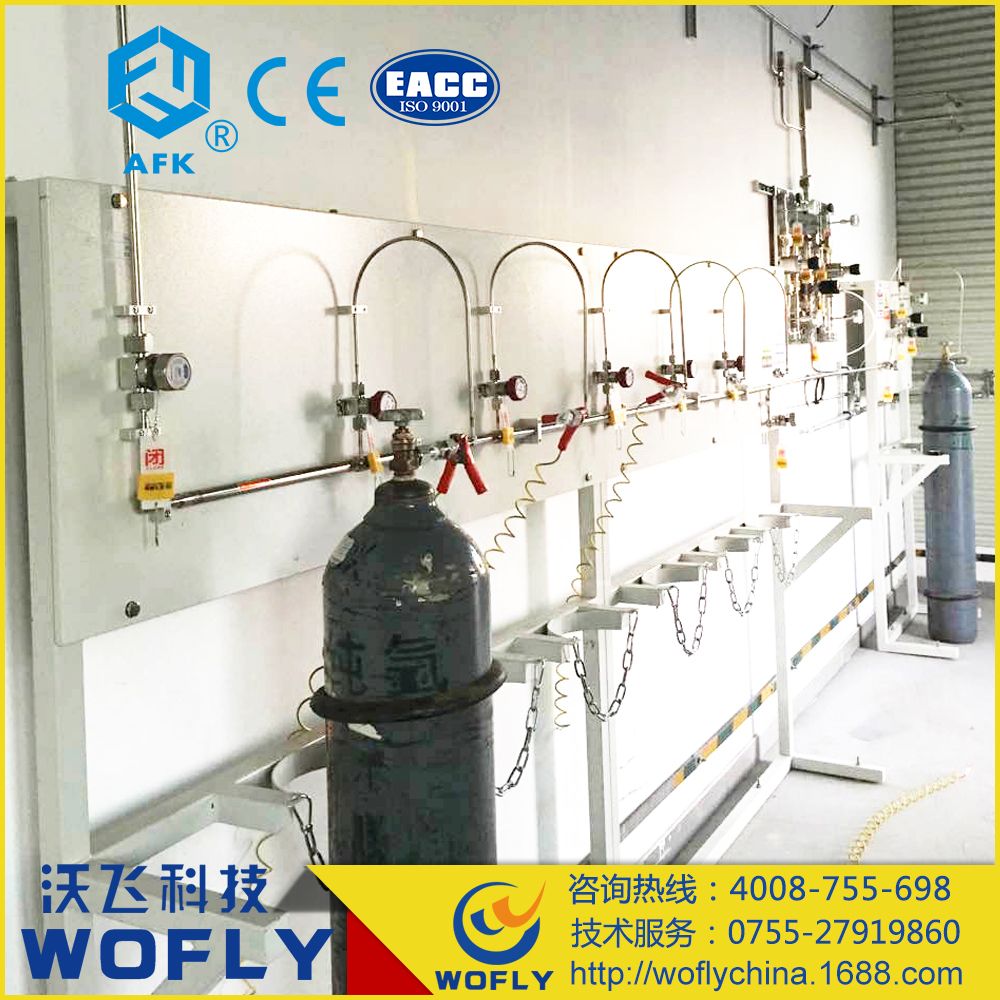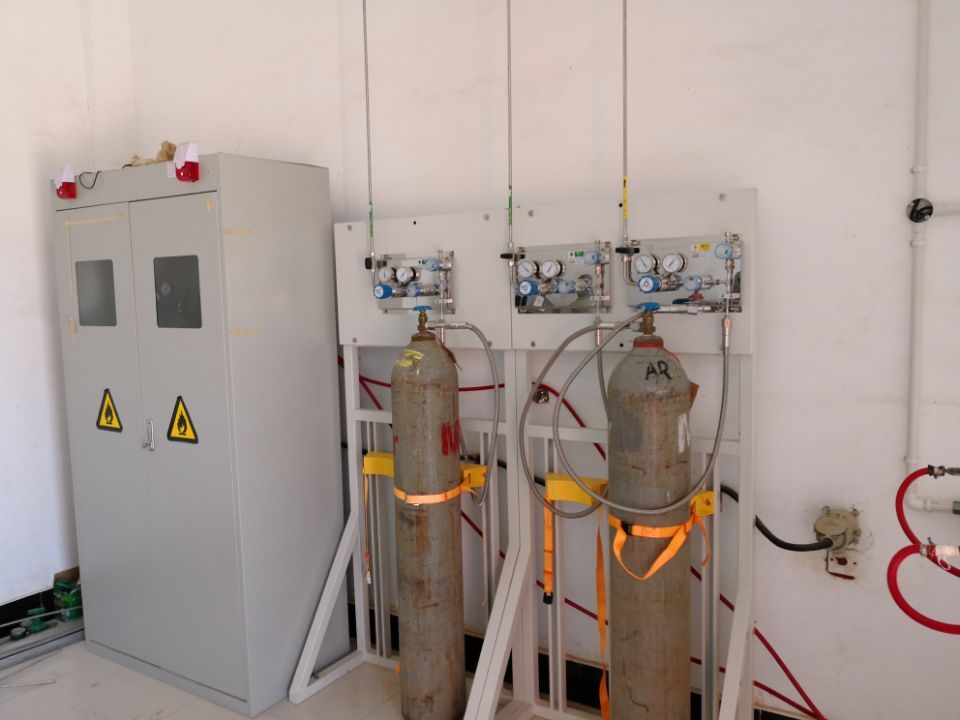1. Laboratory gas types
ed in laboratories with precision instruments, experimental gases (chlorine gas) and gas, compressed air, etc. used in the experimental gas (chlorine gas) and auxiliary experiments in the laboratory, compressed air, etc. High -pure gases are mainly gas (nitrogen, carbon dioxide), inert gas (grillets, sorbe), flammable gas (hydrogen, acetylene), and help gas (oxygen), etc.
Laboratory gas is mainly provided by gas cylinders. Individual gases can be provided by gas generators. Commonly used bonds to distinguish and sign: oxygen cylinders (sky blue black), hydrogen cylinders (dark green red words), nitrogen cylinders (black yellow characters), compressed air cylinders (black white), acetylene bottle (white red) carbon dioxide bottle ( Green and white), cylinders (gray green), cylinder cylinders (brown).

2. Laboratory gas supply method
The laboratory gas supply system can be divided into decentralized gas supply and concentrated gas supply according to its supply method
2.1.Diversified gas supply is to place gas cylinders or gas generators in each instrument analysis room, close to the instrumental gas point, convenient use, saving gas, and less investment; Use explosion -proof gas cylinder cabinets, and to be alarm and exhaust function. Alarm is divided into combustible gas alarm and non -combustible gas alarm. The gas cylinder cabinet should have a gas cylinder safety prompt sign, and the gas cylinder safety fixed device.
2.2. Concentrated gas supply is a variety of gas cylinders that need to be used by various experimental analysis instruments, all of which are placed in independent gas cylinders outside the laboratory for centralized management. Various types of gases are transported in the form of pipelines between gas cylinders and according to different experiments according to different experiments. The gas use of the instrument is transported to different experimental instruments in each laboratory. The entire system includes the pressure control part of the gas source set pressure (convergence row), the gas pipeline (EP -level stainless steel pipe), the secondary pressure regulating diversion part (function column), and the terminal part (connector, cut -off valve) connected to the instrument. The entire system requires good gas tightness, high cleanliness, durability, and safety and reliability, which can meet the requirements of experimental instruments for continuous use of various types of gases. Gas pressure and traffic are adjusted throughout the entire process to meet the requirements of different experimental conditions.
Concentrated gas supply can realize the centralized management of gas sources, stay away from the laboratory to ensure the safety of the experiments; however, the gas supply pipeline leads to waste gas, and the gas source will be opened or closed to the gas cylinder, which is not convenient to use.
3. Safety specifications between gas cylinders and gas cylinders
3.1. The gas cylinder should be dedicated to the bottle, and other types of gas cannot be modified at will.
3.2. The gas cylinder room is strictly forbidden to be close to fire sources, heat sources, and corrosive environments.
3.3. The gas cylinder room is not allowed to use explosion -proof switches and lamps, and bright fires are prohibited around.
3.4. The gas cylinder room should have ventilation equipment to keep it cool. At the top of the gas cylinder room, there should be leakage holes to prevent the gathering of hydrogen.
3.5. The empty bottle and the solid bottle are placed. The flammable and explosive cylinder of the gas cylinder should be isolated from the gas cylinder.
3.6. The attachments such as the bottle valve, the receiving screw and the pressure decompression valve are intact, and the dangerous situations such as leakage, sliding wire, and acupuncture pins are generally not mixed.
3.7. When the gas cylinder must be stored upright when storing and use, when the working location is not fixed and moving frequently, it should be fixed on a special hand -to -hand car to prevent dumping. It is strictly forbidden to use it.
3.8. The gas cylinder is strictly prohibited from the fire source, thermal source and electrical equipment, and the distance from the light fire is not less than 10m. When used at the same time, the oxygen cylinder and acetylene gas cylinder cannot be placed together
3.9. The empty bottle after use should be moved to the empty bottle storage area, and the label of the empty bottle should be prohibited.
3.10. The gas in the gas cylinder should not be used, and a certain amount of residual pressure must be maintained.
3.11. The gas cylinder must be tested on a regular basis. The test cycle of the use of oxygen cylinders and acetylene gas cylinders must not be used. The testing cycle of liquefied petroleum cylinders is 3 years, and the testing cycle of the cylinder and nitrogen cylinder is 5 years.
3.12. The cylinder should be placed in the cylinder storage room outside the theme building. For the daily gas volume of no more than one bottle, the laboratory can prevent a gas cylinder of this kind of gas, but the gas cylinder should have safety protection facilities.
3.13. There should be ventilation measures that should not be less than three times per hour.
4. Gas pipeline design specification
4.1. Yiming, hydrogen, oxygen and gas pipelines, and various gas pipelines in the laboratory. When the pipeline shaft and pipeline technology layer is equipped with hydrogen, oxygen, and gas pipelines, there should be ventilation measures of 1 ~ 3 times/h.
4.2. The general laboratory designed according to the standard unit combination, various gas pipelines should also be designed according to the standard unit combination.
4.3. The gas pipes of the laboratory wall or floor should be laid in the embedded sleeve, and the pipe section in the sleeve should not have welds. Non -combustible materials are used between the pipeline and the sleeve.
4.4. The end of the hydrogen and oxygen pipelines should be set up on the highest point. The empty tube should be above 2m above the layer and should be located in the lightning protection zone. Sample points and blowouts should also be provided on the hydrogen pipeline. The position of the empty pipe, sampling port and blowing mouth should meet the requirements of gas blowing and replacement in the pipeline.
4.5. Hydrogen and oxygen pipelines should have a ground -to -electrical grounding device. The grounding and cross -connection measures with grounding requirements shall be implemented in accordance with relevant national regulations.
5. Pipeline layout requirements
5.1. The pipelines that transport dry gases should be installed horizontally. The pipelines that transport the humid gas should be not less than 0.3%of the slope, and the slope is to the condenser liquid collector.
5.2. Oxygen pipelines and other gas pipelines can be laid in the same frame, and the distance between the distance must not be less than 0.25m. Oxygen pipeline should be above other gas pipelines except the oxygen pipeline.
5.3. When the hydrogen pipeline and its abundant gas pipeline are laid in parallel, the spacing should not be less than 0.50m; when the intersection is laid, the spacing should not be less than 0.25m. When laying layers, the hydrogen pipeline should be above. Indoor hydrogen pipes should not be laid in the ditch or buried directly. Do not pass a room that is not applicable.
5.4. Gas pipes must not be laid with cables and store lines.
5.5 .Gas pipes should be seamless steel pipes. Gas with a purity of gas is greater than or equal to 99.99%of the gas pipelines, stainless steel pipes, copper pipes or seamless steel pipes.
5.6. Gas pipes should be seamless steel pipes. Gas with a purity of gas is greater than or equal to 99.99%of the gas pipelines, stainless steel pipes, copper pipes or seamless steel pipes.
5.7. The connection section of the pipeline and the equipment should be metal pipes. If it is a non -metal hose, polytrafluoroethylene tubes and polyvinyl chloride tubes should be adopted, and latex tubes shall not be used.
5.8. The connection section of the pipeline and the equipment should be metal pipes. If it is a non -metal hose, polytrafluoroethylene tubes and polyvinyl chloride tubes should be adopted, and latex tubes shall not be used.
5.9. Materials of valves and attachments: Copper materials must not be used for hydrogen and gas pipelines. Other gas pipelines can be made of copper, carbon steel and forged cast iron. The attachments and instruments used in hydrogen and oxygen pipelines must be a special product of the medium, which must not be used on behalf of them.
5.10. The valve and oxygen contact part should be non -combustible materials. Its closed ring should be made of non -ferrous metals, stainless steel and polytefluoroethylene. The filler shall be treated with graphite or polytrafluoroethylene by oil removal.
5.11. The material of the flanges in the gas pipe should be determined by the medium transported in the tube.
5.12. The connection of the gas pipeline should be welded or flangeed. The hydrogen pipes shall not be connected with a thread, and the high -pure gas pipeline should be welded.
5.13. The connection between the gas pipe and the equipment, valve and other attachments should be connected by flange or threads. The wire buckle fillers of the threaded joint should be adopted by a polytetrafluoroethylene film or a leading and glycerin blending filler.
5.14. Safety technologies for gas pipeline design should conform to the provisions of the fireproofer on the support of the hydrogen equipment and the hydrogen pipe of each (group) equipment.
5.15. Various gas pipelines should be set up with obvious signs.

Post time: May-23-2022